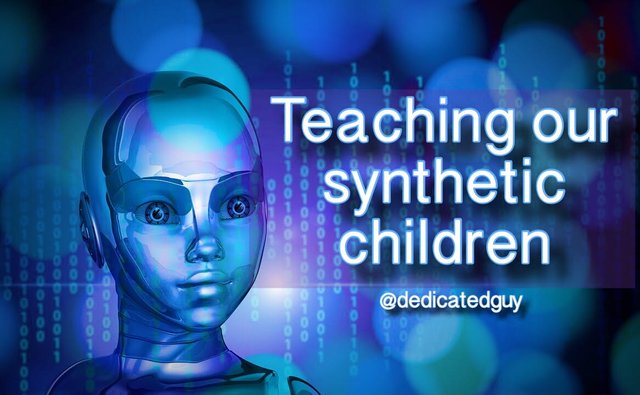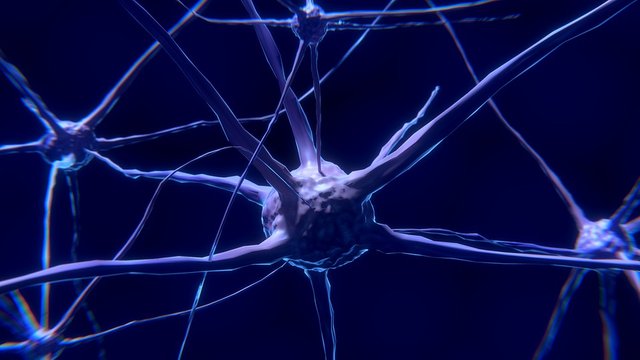Teaching our synthetic children


Having smart AIs is extremely helpful since they can be used to solve problems much faster than us, nevertheless in our effort to check if an AI is capable of overcoming human mental capacities, of reinventing itself and improving itself, because in addition to thinking like a human, this synthetic brain should be designed to learn on its own, to become aware of its actions and to feel responsible for its decisions.
If we pretend to compete with a computer playing chess, we would surely lose everytime. The machine is faster and safer than our mind, but, even recognizing this inferiority, We have an advantage over it: we can improve by learning and training.

If we want our synthetic creations to thrive we need to teach them how to learn for themselves. So they can do it on a permanent basis.
Just so you can see how difficult this is to accomplish, let's think about what we would need to teach a computer so it can learn how to interpret natural language using the rules system. An expert linguist should advise the programmer to codify the orthographic and grammatical norms, integrating them into the program in the form of rules. Logically all the exceptions that exist in these norms (for example, the irregular verbs) should also be made explicit and, unfortunately, the language usually has as many exceptions as rules.
But the problem would not end there. The language is ambiguous and consequently we would also have to instruct our computer to be able to resolve the ambiguities. For example: "Charles does not want Tom because he is rude." We do not know who is rude, Charles or Tom.
In short, teaching a computer is not an easy task and usually requires a great human effort. In the short history of AI, learning mechanisms based on different algorithms have been tried and none of them has been able to solve this problem.
Enter Deep Learning

Deep Learning is a new area of Machine Learning research, which has been introduced with the objective of moving Machine Learning closer to one of its original goals: Artificial Intelligence. | Source
Deep learning is a type of machine learning that trains a computer to perform human-like tasks, such as recognizing speech, identifying images or making predictions. Instead of organizing data to run through predefined equations, deep learning sets up basic parameters about the data and trains the computer to learn on its own by recognizing patterns using many layers of processing. | Source
The development of Deep Learning techniques on neural networks has meant a real revolution in the field of machine learning. These techniques allow the computer to learn by itself and improve their knowledge autonomously through training.
Lets now define what is a Neural Network
A neural network is a system of hardware and/or software patterned after the operation of neurons in the human brain. | Source
They are based on processing cores interconnected with each other analogously to how neurons in the brain are linked (synaptic connections). These artificial neurons are known as perceptrons.
What is a perceptron?
A perceptron is an algorithm for supervised learning of binary classifiers (functions that can decide whether an input, represented by a vector of numbers, belongs to some specific class or not) | Source
The perceptrons have different interconnected levels. The first one is the one who receives the input from the outside, for example, the picture of the bear face. Then, after processing this image, a new input is generated for the second level of the perceptrons, this dynamic keeps going until the highest level of the perceptrons manage to put together every input received.
Let’s imagine, for example, that an artificial neural network tried to recognize the face of a bear.
A camera would capture its complete image, decomposing it into multiple pixels. Each pixel is treated by a first level perceptron, which analyzes a series of attributes linked to that image (color, brightness, length, thickness, angles, distances between points, relative positions, etc.). The perceptron takes into account all these attributes, assigning each of them a level of importance within the recognition process, that is, a weight. This set of attributes and their associated weights constitute what is called a pattern recognition.

By applying an algorithm on that pattern, the perceptron decides whether or not what it sees is a fragment of a bear's face. This information, together with that provided by the rest of the perceptrons of the same level, is successively combined with those of the following neuronal levels until the recognition at the higher level is completed.
Fortunately and thanks to the Internet, the machine has millions of images of bears available to use. Through training, analyzing those millions of images, each perceptron adjusts itself by its recognition pattern and, once achieved, the machine is able to identify the image of the bear in any scenario.
What the neural network would come to recognize is the global pattern of the bear’s face, that is, the relationships (relative positions, angles, etc.) between the different parts that make it up, relations that are always maintained, regardless if the image shown is dark, rotated or inverted.
In fact, we already have commercial uses to this technology in the form of the iPhone X and its Face ID feature, which allows you to unlock the phone (among other things) simply by scanning your face. Here is the video from Apple:
According to their website
A portion of the A11 Bionic chip's neural engine — protected within the Secure Enclave — transforms the depth map and infrared image into a mathematical representation and compares that representation to the enrolled facial data. | Source
Conclusion

Everything seems to indicate that Deep learning and neural networks show the way forward in terms of machine learning, although we are barely even taking the first steps. Its complexity relegates them for the moment to quite restricted scenarios, but it is not difficult to imagine its widespread use in many fields related to AI in the short term. In the long term, pretty much everything is possible, from a world completely ruled by AIs to a future in which we evolve past our biological bodies to become synthetic beings improving ourselves at an exponential rate.
Maybe in the future, there will be no difference between an originally biological intelligence (us) and an originally synthetic one. Perhaps even the definition of the word human will be changed in the future to remove the biological part. There is no question that if we manage to transcend ourselves to a synthetic environment using the knowledge we are gathering right now about artificial intelligence, our potential could be limitless.
How do you think the development of AIs can affect our futures? Do you think the benefits outweigh the risks?
References
Deeplearning
sas
technopedia
expertsystem
searchnetworking
Wikipedia - perceptron
merriam-webster
Apple
If these titles sound interesting to you, I assure you the articles will be even better!

Why forgiveness is important if we want to thrive?
Can a lesser intelligence create a greater one? Of course it can!
Don’t forget to be grateful with life
Shaping our future by learning from others
How can we create the future by thinking about it?
About our most valuable possession.

The future is already here.. So many hidden operations happening all around the world. Experimenting on society.
Thanks for the thought-provoking article!
You are welcome! There are tons of thought provoking subjects about the future!
The main thing is that there is no rebellion of machines)) Interesting, thanks!)
There is no need for one since we will probably join them
to become aware of its actions and to feel responsible for its decisions
at the moment AI's are below par when compared to cockroaches.
Self-awareness is a thing...and we have ZERO idea what causes it and a very poor idea of evenhow to identify it.
Are cats self aware? yeah I'm pretty sure that they are (I live with one)
How about a snake?
or a tarantuala?.
The claustrum is what allow us to have conscience. Self awareness is more complicated.